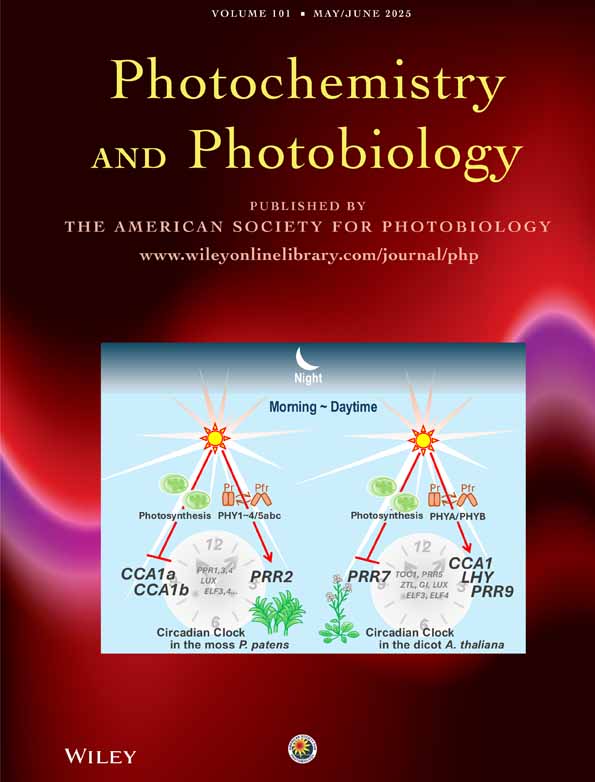INTRAMOLECULAR EXCIMER FLUORESCENCE: A NEW PROBE OF PHASE TRANSITIONS IN SYNTHETIC PHOSPHOLIPID MEMBRANES
Corresponding Author
D. Georgescauld
*To whom correspondence should be sent.Search for more papers by this authorJ. P. Desmasèz
†Centre de Recherches Paul Pascal, Domaine Universitaire, 33405 Talence Cedex, France
Search for more papers by this authorR. Lapouyadej
‡Laboratoire de Chimie Organique, Université de Bordeaux I, 33405 Talence Cedex, France
Search for more papers by this authorA. Babeau
†Centre de Recherches Paul Pascal, Domaine Universitaire, 33405 Talence Cedex, France
Search for more papers by this authorH. Richard
†Centre de Recherches Paul Pascal, Domaine Universitaire, 33405 Talence Cedex, France
Search for more papers by this authorMitchell Winnik
§Department of Chemistry & Erindale College, Lash Miller Laboratories, University of Toronto, Toronto, Canada M5S 1A1
Search for more papers by this authorCorresponding Author
D. Georgescauld
*To whom correspondence should be sent.Search for more papers by this authorJ. P. Desmasèz
†Centre de Recherches Paul Pascal, Domaine Universitaire, 33405 Talence Cedex, France
Search for more papers by this authorR. Lapouyadej
‡Laboratoire de Chimie Organique, Université de Bordeaux I, 33405 Talence Cedex, France
Search for more papers by this authorA. Babeau
†Centre de Recherches Paul Pascal, Domaine Universitaire, 33405 Talence Cedex, France
Search for more papers by this authorH. Richard
†Centre de Recherches Paul Pascal, Domaine Universitaire, 33405 Talence Cedex, France
Search for more papers by this authorMitchell Winnik
§Department of Chemistry & Erindale College, Lash Miller Laboratories, University of Toronto, Toronto, Canada M5S 1A1
Search for more papers by this authorAbstract
Abstract— The molecule (1,1'-dipyrenyl)-methyl ether [dipyme] shows intramolecular excimer fluorescence in competition with fluorescence from the locally excited pyrene chromophore. This intensity ratio Ic/Im is sensitive to solvent viscosity. The molecule is soluble in synthetic phospholipid membranes. 1H NMR studies suggest that the molecule is localized in the hydrocarbon region of the membrane. Fluorescence measurements at various temperatures of dipyme dissolved in these membranes show that Ic/Im is exceedingly sensitive to fluidity changes accompanying both the pretransitions and the gel to liquid crystalline transitions of the membrane. These studies can be carried out at a mole ratio of probe to lipid 102-103 smaller than that necessary to observe bimolecular pyrene excimer formation.
References
- Azzi, A. (1975) Quart. Rev. Biophys. 8, 237–316.
- Badley, R. A. (1976) In Modern Fluorescence Spectroscopy, Vol. 2 (Edited by E. L. Wehry), pp. 138–139. Plenum Press, New York .
- Birks, J. B. (1971a) Photophysics of Aromatic Molecules, pp. 301–370. Wiley, New York .
- Birks, J. B. (1971b) Photophysics of Aromatic Molecules, pp. 441 ff. Wiley, New York .
- Birks, J. B. (1975) Rep. Prog. Phys. 38, 903–974.
- Brandt, L. and J. R. Gohlke (1972) Ann. Rev. Biochem. 41, 843–868.
- Bruce. T. and S. J. Benkovic (1966) Bioorganic Mechanisms. Benjamin. New York .
- Chandross, E. A. and D. J. Dempster (1970) J. Am. Chem. Soc. 92, 3586–3596.
- Chapman, D., R. M. Williams and B. D. Ladbrooke (1967) Chem. Phys. Lipids 1, 445–475.
-
de Schryver, F. C.,
N. Boens and
J. Put (1977) Adv. Photochem.
10, 359–465.
10.1002/9780470133408.ch6 Google Scholar
- Duclohier, H. (1977) These de Docteur Ingenieur, Universite de Bordeaux 1.
- Eisinger, J., M. Gueron, R. G. Sulman and T. Yamane (1966) Proc. Natl. Acad. Sci. U.S.A. 55, 1015–1020.
- Emert, J., C. Behreus and M. Goldenberg (1979) J. Am. Chem. Soc. 101, 771–772.
- Faucon, J. F. and C. Lussan (1973) Biochim. Biophys. Acta 307, 459–466.
- Galla, H. J. and E. Sackmann (1974) Biochim. Biophys. Acta 339, 103–115.
- Georgescauld, D. and H. Duclohier (1978) Biochem. Biophys. Res. Commun. 85, 1186–1191.
- Goldenberg, M., J. Emert and H. Morawetz (1978) J. Am. Chem. Soc. 100, 7171–7177.
- Graetzel, M. and J. K. Thomas (1973) J. Am. Chem. Soc. 95, 6885–6889.
- Halpern, A. M. and P. P. Chan (1975) J. Am. Chem. Soc. 97, 2971–2976.
- Hinz, H.-J. and J. M. Sturtevant (1972) J. Biol. Chem. 247, 3697–3701.
- Hirayama, F. (1965) J. Chem. Phys. 42, 3163–3171.
- Johnson. G. E. (1974) J. Chem. Phys. 61, 3002–3008.
- Johnson, G. E. (1975) J. Chem. Phys. 63, 4047–4053.
- Klopffer, B. (1975) In Organic Molecular Photophysics Vol. 1., (Edited by J. B. Birks), Chapter 7. Wiley. New York .
- Ladbrooke, B. D., R. M. Williams and D. Chapman (1968) Biochim. BioPhys. Acta 164, 101–109.
- Mantulin. W. W. and H. J. Pownal (1977) Photochem. Photohiol. 26, 69–73.
- Masuhara, H., K. Kaji and N. Mataga (1977) Bull. Chem. Soc. Jpn 50, 2084–2087.
- Podo, F. and J. K. Blasie (1977) Proc. Natl. Acad. Sci. U.S.A. 74, 1032–1036.
-
Radda, G. K. (1971) In Current Topics in Bioenergetics (Edited by
D. R. Sanedi), pp. 81–125. Academic Press,
New York
.
10.1016/B978-0-12-152504-0.50009-5 Google Scholar
- Radda, G. K. and J. Vanderkooi (1972) Biochim. BioPhys. Acta 265, 509–549.
- Sackmann, E. (1976) Z. Phys. Chem. (Frankfurt am Main) 101, 391–416.
- Shimshick, E. J. and H. M. McConnell (1973) Biochemistrv 12, 2351–2360.
- Singleton, W. S., M. S. Grey, M. L. Brown and J. L. White (1965) J. Am. Oil Chem. Soc. 42, 53–56.
- Trauble, H. (1971) Naturwissenschaften 58, 277–284.
- Turro, N. J. A. Aikawa and A. Yekta (1979) J. Am. Chem. Soc. 101, 772–774.
- Vanderkooi, J. M. and J. B. Callis (1974) Biochemistrv 13, 4000–4006.
- Wang, Y. C. and H. Morawetz (1976) J. Am. Chem. Soc. 98, 3611–3615.
- Zachariasse, K. (1978) Chem. Phys. Lett. 57, 429–432.
- Zachariasse. K. and W. Kiihnle (1976) Z. Phys. Chem. (Frankfurt am Main) 101, 267–276.




